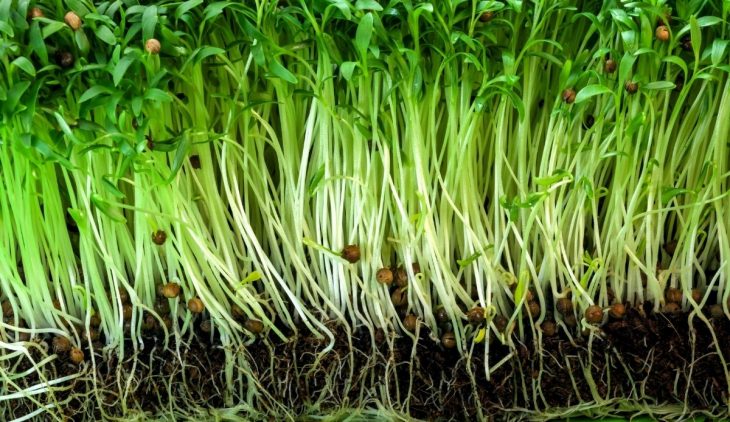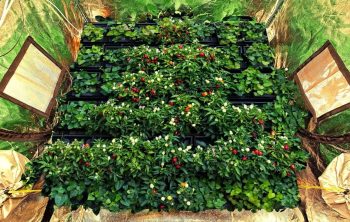Have you ever wondered what cilantro plants look like when they sprout? Let’s find out. Germinating cilantro from the beginning with seeds may be frustrating, even for the most experienced gardener.
With the proper knowledge and the appropriate growing settings, you can achieve successful cilantro germination.
So, once you have achieved growing cilantro from seeds and it begins to germinate, we would like to know what exactly it looks like when it sprouts.
This post will give you an idea of how cilantro looks when it sprouts, tips on how to grow or germinate cilantro successfully, and many more. So, continue reading to gain some insight on these.
What Do Cilantro Sprouts Look Like?
So, what exactly does the cilantro look like when it sprouts? Once you’ve perfected the growing requirements for the cilantro seed to grow, you should begin to see some sprouts.
After sowing cilantro seeds for about seven days or less, you should notice some white sprouts emerging from the seed planted. You can easily check this out by slowly exposing the
Cilantro sprouting will result in green sprouting that should begin to emerge through the

How Long Does Cilantro Take To Grow?
Once you’ve planted or sown the cilantro seeds, sprouting or germination should begin after 7 to 10 days.
However, cilantro germinating from seeds can be pretty tricky. You need to create the ideal seed setting so your seed can germinate.
Tricks To Growing Cilantro To Get A Successful Germination
You can grow cilantro from seeds either in your garden or in containers. So, to achieve germinating cilantro successfully, follow these tips:
1. Prepare the cilantro seed by soaking
Cilantro seeds are inside a hard husk containing two seeds. Remove the husk to remove the seeds. Before you plant these seeds, you need to prepare them to boost their chance of germinating.
Soaking the cilantro seed is the trick to achieving better germination. Therefore, soak the seeds for 10 to 48 hours, remove the water, and allow the seeds to dry. Soaking these seeds will help them grow better and quicker.
2. Planting
After seed preparation follows planting, you can sow your cilantro seeds indoors or outdoors. Insert the seeds into the
(Set of 2), Sprouting Jar Kit for Organic Sprouts, Alfalfa & Mung Bean Sprouts Grow Kit, 316 ...
3. Watering
Maintain moist
4. Thinning
You should start noticing white sprouting after 7 to 10 days. Allow the cilantro to germinate until it is about 2 inches long. Then, thin the seedlings to about 3 to 4 inches apart.
Grow cilantro in a crowded environment so the leaves can shade the plant roots. This will slow down the plant’s bolting during hot weather.
5. Sunlight
Even though the cilantro plant doesn’t like too much sunlight, the seedlings still need a few hours of full sun. Cilantro can still tolerate light shade.
If you’re growing in a container, provide the seedlings with some sunlight. However, ensure the sunlight exposure to the seedlings is not more than 4 to 5 hours of full sun; otherwise, it can cause wilting and even death of the plant.
Then, two or three weeks later, you can slowly increase your cilantro plants’ outdoor exposure. This way, they can harden off and acclimate to the outdoor conditions.

Ideal Growing Conditions For Cilantro
Here are some additional growing tips for you to enjoy a continuous harvest of cilantro leaves:
- Cilantro should be grown in rich and properly draining
soil . - Cilantro still requires some sunlight, but not too much, so it doesn’t enter the bolting stage. If you reside in a warmer region, it’s advisable to offer afternoon shade to your cilantro.
- The ideal pH range for a cilantro plant to grow optimally is around 6.2 to 6.8. So, ensure you perform the appropriate
soil test before planting to achieve this. - You can enhance the
soil by incorporating and mixing inches of compost or other organic matter. If you’re growing cilantro in containers, consider a premium bagged potting mix. - To enjoy productive leaf production, supply your cilantro by constantly feeding it with water-soluble plant food.
When To Plant Cilantro
You should plant cilantro in early spring or fall, about a month before the last frost. For zone 8, 9, and 10, the best period to plant cilantro is around fall. This is mainly because the plant tends to last through the right until the weather warms or heats up during late spring.
Harvesting And Storing Cilantro
Cilantro’s foliage can be harvested continually, and you can enjoy the cut-and-come-again feel. Ensure you cut back all the leaves so they can grow back. It would be best to harvest the leafy stems near the ground level.
However, don’t harvest more than 1/3 of the leaves at once to prevent weakening the stem. Simply harvest what you need at a time to promote vigorous growth.
Once cilantro is grown under the appropriate conditions with constant harvest, it can be enjoyed for many weeks in continuous production.
Storing
Once you’ve harvested cilantro leaves, cover them loosely with an upside-down plastic bag and pop them in the fridge. Using this method, you can store cilantro for up to a month.
FAQ’s
What does cilantro look like when it starts to sprout?
The seeds are blackish-green and look like black pepper. Once the seeds germinate, they grow upward, looking somewhat like a green bean. After a few weeks, the leaves begin to emerge.
Cilantro is a perennial herb with leaves that look like miniature versions of the lettuce leaf. Cilantro is a very popular and versatile herb for cooking and seasoning. It is easy to grow and is great as an addition to your kitchen garden. A cilantro plant can be grown from seed in many different ways, but one of the easiest ways is to start them indoors in a seed starting mix.
The seedlings will be ready to transplant out into their permanent home in approximately 7-10 weeks.
How can you tell if a plant is cilantro?
There are a few ways. The first is to look at the leaves. If they are large and round with a nice strong aroma, that's probably cilantro. The second is to look at the stems. They should be green and fibrous. There's not much to look at for basil. The third is to look at the seeds. If the seeds are small and hard, that's probably cilantro.
The herb cilantro (Coriandrum sativum) has become ubiquitous in the American kitchen. It is used as an ingredient in everything from salad dressings and marinades to soups, stir-fries, chili, sauces, and even desserts.
If it's not the fresh, familiar herb that adds so much flavor to soups and stews, it may be the dried spice known as coriander. It's a member of the parsley family, and it's often called "the other cilantro" because it's hard to find fresh cilantro and easier to find dried coriander.
Will cilantro grow back after cutting?
You can get a second crop, but you might have to wait until next year.
Your cilantro should recover and produce new leaves for another season.
What is the best time of year to plant cilantro?
Planting in late fall gives your cilantro a chance to grow through the winter. If you start early in the spring, the plants won’t have a chance to put down roots before they’re killed by cold temperatures.
What is the difference between fresh and dried cilantro?
Fresh cilantro has a much more potent aroma than dried cilantro. The taste is also more pungent. Dried cilantro is usually sold in small bags and can be added to soups, sauces, rice dishes, etc. Fresh cilantro is used in dishes with Mexican or Asian flavors. Dried cilantro is used in dishes with Indian or Thai flavors.
How do you make fresh cilantro last longer?
When your cilantro begins to wilt, don’t throw it away. Instead, place the wilted cilantro in a plastic bag and seal it. Store the cilantro in the refrigerator for up to a week.
How do you grow cilantro?
Cilantro can be grown from seed or transplanted. To germinate seeds, place them in a tray and cover them with a damp towel. You can also sow the seeds directly into the ground. The seeds are ready to transplant when they have sprouted and have developed two true leaves. If you plant the seeds indoors, you should put them in individual pots about four weeks before planting outside. To grow cilantro outdoors, you’ll need to provide it with at least six hours of direct sunlight every day.
What Does Cilantro Look Like When It Sprouts: Conclusion
When it comes to what cilantro looks like when it sprouts, some white sprouts are usually noticed once it begins to germinate. This is noticed 7 to 10 days after seed sowing. Then, a few days later, some green sprouts should be seen emerging from the seed sown.

Eunice is an enthusiastic gardener with a passion for growing beautiful flowers. She loves nothing more than spending time in her garden, tending to her plants and enjoying the outdoors. Eunice has been gardening for over 15 years and has developed a unique style of landscaping that is both practical and aesthetically pleasing. She is especially fond of growing roses and enjoys experimenting with different varieties and colors. Eunice takes great pride in her garden and often shares the fruits of her labor with friends and family. In her spare time, she enjoys reading gardening magazines and attending local horticulture events. Eunice is passionate about her hobby and is always eager to share her knowledge and experience with others.





